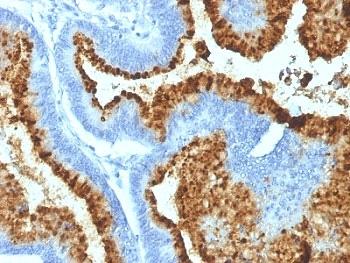- Tel: 858.663.9055
 Email: info@nsjbio.com
Email: info@nsjbio.com
- Tel: 858.663.9055
- Email: info@nsjbio.com
Blood Group Antigen B Antibody reagents target the B antigen, one of the two primary carbohydrate antigens that define the ABO blood group system. The B antigen is formed when α-1,3-galactosyltransferase modifies the precursor H antigen by adding galactose residues. This biochemical modification distinguishes individuals with blood type B or AB, while those with blood type A lack this structure, and type O individuals express unmodified H antigen.
Blood group antigens, including A, B, and H, play vital roles in transfusion medicine, transplantation, and susceptibility to infectious diseases. The Blood Group Antigen B Antibody provides a reliable means of detecting this antigen in red blood cells and tissues. Meanwhile, the ABO Antibody category supports broader applications in hematology, transfusion compatibility, and immunological research.
NSJ Bioreagents provides Blood Group Antigen B Antibodies validated for immunohistochemistry, western blotting, flow cytometry, immunofluorescence, and ELISA. Each Blood Group Antigen B Antibody undergoes rigorous validation to ensure specificity, reproducibility, and compatibility with clinical and research workflows.
By choosing Blood Group Antigen B Antibodies from NSJ Bioreagents, researchers gain reagents optimized for reliability and clarity. Our antibodies deliver robust staining in red blood cell preparations, reproducible antigen detection in protein lysates, and dependable performance across discovery and diagnostic applications. Detailed datasheets, suggested positive controls, and validated protocols ensure reproducibility in both laboratory and translational research.
The Blood Group Antigen B Antibody supports wide-ranging applications across hematology, immunology, and clinical science.
Blood Group Antigen B Antibodies confirm expression of B antigen on red blood cells.
The Blood Group Antigen B Antibody supports compatibility testing and ABO grouping.
ABO Antibody reagents complement transfusion research and diagnostics.
Blood Group Antigen B Antibodies help clarify the enzymatic conversion of H antigen.
The Blood Group Antigen B Antibody supports molecular studies of glycosyltransferases.
ABO Antibody reagents provide broader context for immunohematology workflows.
Blood Group Antigen B Antibodies identify ABO incompatibility in solid organ and stem cell transplants.
The Blood Group Antigen B Antibody supports cross-matching and compatibility testing.
ABO Antibody reagents validate biomarker panels in transplantation studies.
Blood Group Antigen B Antibodies clarify roles of ABO antigens in pathogen susceptibility.
The Blood Group Antigen B Antibody supports studies into malaria and viral infections.
ABO Antibody reagents contribute to epidemiological and translational research.
Blood Group Antigen B Antibodies detect antigen expression during hematopoietic development.
The Blood Group Antigen B Antibody supports stem cell differentiation and organoid models.
ABO Antibody reagents extend these studies into regenerative medicine.
Blood Group Antigen B Antibodies are integrated into biomarker-driven transfusion studies.
The Blood Group Antigen B Antibody supports clinical workflows in precision diagnostics.
ABO Antibody reagents ensure reproducibility in translational pipelines.
The B antigen is one of the cornerstones of the ABO system, governing compatibility in transfusion and transplantation. The Blood Group Antigen B Antibody equips researchers and clinicians with validated tools for antigen detection, compatibility testing, and biomarker validation. The ABO Antibody provides complementary support for broader hematology and immunology research.
In transfusion medicine, Blood Group Antigen B Antibodies ensure patient safety by validating compatibility. In hematology, the Blood Group Antigen B Antibody helps clarify biosynthetic pathways. In infectious disease research, ABO Antibody reagents reveal links between blood group antigens and pathogen susceptibility.
Clinically, accurate detection of B antigen remains vital for transfusion safety and transplantation outcomes. Reliable antibodies ensure reproducibility across research, diagnostics, and patient care.
The B antigen defines one of the core ABO blood group types and plays a pivotal role in transfusion medicine and immunohematology. The Blood Group Antigen B Antibody provides validated reagents for studying antigen expression, compatibility, and biosynthesis, while the ABO Antibody supports complementary applications across diagnostics and translational medicine. By ensuring specificity and reproducibility, these antibodies remain indispensable tools for advancing blood group biology and improving patient outcomes.

IHC: Formalin-fixed, paraffin-embedded human colon carcinoma stained with Blood Group B antibody (clone HEB-20, cat # V2552).